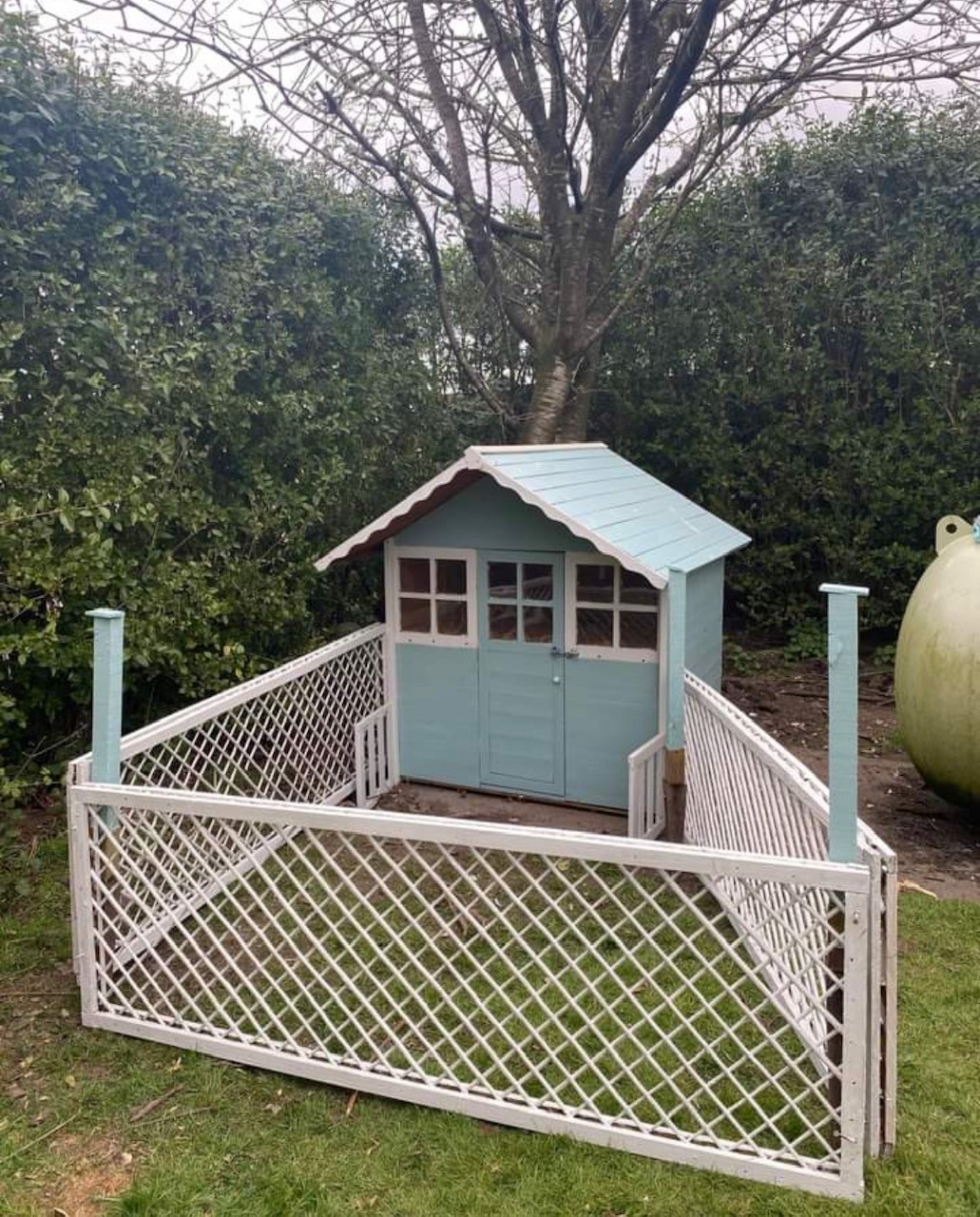
Suitable Rabbit Housing for Animal Welfare
Rabbits are active, intelligent, social animals; they have complex welfare needs that must be met if they are to be happy and healthy. Providing housing that meets rabbits’ complex environmental and behavioural needs is an important part of responsible ownership. Warrington Animal Welfare believes the traditional method of keeping rabbits permanently confined in small hutches is totally inappropriate for the long-term housing of rabbits kept as pets.
Rabbits need a generous outdoor space to run around in and cosy indoor quarters where they can rest and find shelter. Providing them with this will allow them to express their natural patterns of behaviour and so lead happy, healthy lives.
Warrington Animal Welfare supports the Rabbit Welfare Association & Fund ‘A Hutch is Never Enough’ campaign https://rabbitwelfare.co.uk/rabbit-care-advice/rabbit-housing/why-hutch-not-enough/ - rabbits are not designed to live in a confined space. In the wild they cover an area equivalent to 30 football pitches. They're not designed to live alone either - wild rabbits live in large social groups, foraging, grooming each other and huddling together for warmth. Rabbits living alone experience high levels of stress.
Basically: Ideally as big as you can – with access to outside to graze.
Rabbit Hutch/Shed and runs
Rabbits should be housed in a hutch or shed with a run permanently attached to it.
The hutch/shed provides shelter; the run provides space for the rabbits to express natural behaviour such as running, digging, jumping and exploring. The two areas should be connected by a tunnel or the run built onto the front of the hutch/shed.
The run can be on grass or concrete, if grass it's advisable to dig mesh under the grass to help prevent escapes and predators getting in.
Rabbit accommodation size – bigger the better!
We don’t support the use of hutches smaller than 6ft in length, unless they form part of an overall environment that ensures the rabbits are never confined to their living space. Generally, we recommend you stick to our 6ft guideline to be on the safe side.
Rabbits should always be kept with the company of their own kind so a hutch must accommodate 2 rabbits comfortably.
The minimum sizes we recommend for a small-medium pair of rabbits are
-
It should also allow them to make at least 3 hops and lie stretched out. In practice this means a minimum of 6ft long x 2ft deep by 2½ft high (but this is an absolute minimum, bigger is better).
-
The floor space needs to be at least 2 feet from front to back. In a two-tier style hutch, floor space is lost to the ramp so that must be taken into account.
-
Rabbits must be able to stand up on their back legs without their ears touching the top so the hutch must be at least 2½ft tall.
-
Wendy house/shed: 4ft by 4ft. All doors should have strong bolts on to keep safe from predators, swivel latches should be removed.
-
Runs: 3m long by 1.5m wide by 1m high (10ft. long by 5ft. wide by 3ft.high) with a secure lid
For large breeds are minimum requirements are
-
6ft by 4ft shed attached to a 15ft x 5ft x 4ft high run.
-
All doors should have strong bolts on to keep safe from predators and remove swivel latches.
-
Chicken wire is not suitable for rabbit enclosures as predators can easily chew through.
-
Fold away metal runs are not suitable as they are not as strong as a wood/mesh runs and therefore susceptible to predators or rabbits digging out. Unless they are for occasional, supervised use.
We do no support small hutches or chicken-coop style hutches at all, regardless of the dimensions.
Free range rabbits
There are many predators that are a risk to your pet rabbits; therefore we only recommend allowing your rabbits to have supervised free range time in a secure garden. When unsupervised the rabbits should be housed in the secure accommodation as stated above.
Bedding materials for Rabbit Hutches
-
Hutches or sheds can be lined with newspaper, vinyl or carpet. Take care that edges of carpet or vinyl are not visible for the rabbits to chew.
-
Vinyl must always have hay or carpet on top to prevent the rabbits from slipping over.
-
Next you will need hay – lots of it. You can buy large bales of hay at reasonable cost from farm shops and horse suppliers.
-
Rabbits don’t just sleep on hay: it also accounts for about 80 per cent of their diet.
-
Select hay that is light green or light brown in colour and make sure that it smells fresh.
-
Be fussy: coarse, yellowing hay will provide no nutrition; it may also contain parasites.
-
Never use wood shavings or farm straw as bedding.
-
Wood shavings can contain harmful parasites; they also produce dust, which can cause both you and your rabbits breathing problems.
-
Straw is too coarse and has no nutritional value whatsoever – please don’t use it.
-
Rabbits can be easily litter trained, fill litter trays with fresh hay daily as they love to eat at the same time.
-
By providing them with a toilet area, you can make it easier to clean the hutch or shed: simply empty out the trays, spray with pet disinfectant, wipe, and replenish the contents every day.
The whole accommodation should be cleaned out thoroughly once a week using a suitable pet disinfectant.
Find out more about rabbit housing on the RWAF website. https://rabbitwelfare.co.uk/rabbit-care-advice/rabbit-housing/outdoor-rabbit-housing/
Keeping Rabitts indoors
The keeping of rabbits as indoor pets is still becoming more popular as many rabbit owners are realising they can develop a deeper and more rewarding relationship with a rabbit kept indoors. One reason for this is that we tend to spend more time with our pets if they are in the warmth of our homes than if we keep them in the garden.
WAW is not against rabbits being kept in the home, provided this is right for the individual rabbit(s) concerned, the rabbit's individual needs are met, and the rabbit is healthy and happy. Rabbits' welfare needs must be met however they are kept, including the need to protect them from hazards, and this may require some additional thought before acquiring rabbits or bringing them into the home.
-
Owners must ensure rabbits are safe and protected from hazards.
-
All areas that the rabbits will have access must be fully rabbit-proofed (e.g. electric cables and wires should be covered and/or put out of reach, access to dangerous areas (such as near the oven in the kitchen) should be prevented/blocked off, houseplants should be non-toxic or placed out of reach where petals etc. will not fall into areas the rabbits have access to.
-
It's advisable that owners supervise rabbits when they are let out of their secure enclosure/room.
-
You should consider how to gradually get rabbits used to common household sights, noises, sounds, smells, people and pets, if they have not previously been kept inside.
-
You should also ensure that if you have other pets, they will not harm/frighten the rabbits.
-
Rabbits will usually be scared of cats and dogs because they are their natural predators, but if introduced to them carefully early in life they can develop friendships.
-
Never leave your rabbits unsupervised with another animal or person who may (deliberately or accidentally) harm or frighten them.
-
Never leave your rabbits unsupervised with a cat or dog, even if you know they are good friends.
-
Rabbits will need a large, safe enclosure in a quiet part of your home.
-
This enclosure must include; a main shelter and a large, secure exercise area, with additional hiding places. This could be a large, adapted dog pen/crate, a large hutch & run complex or a rabbit-proofed room (with at least one shelter to act as a sleeping/resting area). This provides the rabbit with a safe, familiar place to rest.
-
If the rabbits are to be kept in this enclosure when you are not around to supervise them, it must be large enough & interesting enough for the rabbit to be able to behave normally, exercise and play.
-
The floor of the rabbits' enclosure (and ideally all areas the rabbits have access to) should be non-slip – please note that shiny/polished laminated flooring and tiles can be slippery and therefore stressful for rabbits, so should be covered/avoided in areas the rabbits have access to, where possible.
-
When the rabbits first move into the home, we suggest that they are left within their enclosure for at least 48 hours to allow them time to acclimatise to the sounds and smells of the new environment, whilst feeling safe. This will also help rabbits get used to where their litter trays are located (if provided) and assist in litter training.
-
House rabbits should have daily access to a secure outside enclosure (with a main shelter & hiding places), where they can exercise, dig and graze on growing grass.
-
Owners should think about how to provide for needs which cannot easily be met inside the home, including grazing and digging. Provision of kiln-dried grass and growing grass in trays/pots will allow rabbits to show normal grazing behaviour. Providing opportunities to dig (in suitable places) should also be encouraged, e.g. by giving rabbits a 'dig box' filled with earth or child-safe play sand.
-
If rabbits are provided with suitable toys and activities (which are regularly rotated to avoid boredom) they will be less likely to chew/dig furniture. Owners may need to prevent access/use welfare-friendly deterrents (such as covering table legs with a safe material) to protect valuable furniture.
-
Rabbits are intelligent and can be taught to respond to commands via clicker training. They can also be litter trained. The toilet area(s) should be separate to where rabbits’ sleep. Rabbits may need to be confined to their enclosure area while they are being litter trained. Adding some used litter material and droppings to the trays will help rabbits learn to toilet in these areas. Adding a hay rack above the litter tray(s) may encourage the rabbits to eat more hay. We advise that you provide at least one tray per rabbit (with ideally one more in addition).
Enrichment/environment for Rabbit
-
Once you have thought about the right accommodation you then need to consider enrichment for the run.
-
Enrichment helps the rabbits to keep fit and happy.
-
Children’s sand pits filled with soil or play sand, fruit tree or willow logs, children’s chairs, tunnels, plant pots, trays growing in trays and pots and card board boxes all make great additions.
Our adoption contract states that if you’re new family member is not working out, to contact WAW and we will accept the rabbit back and start the rehoming procedure again. Do not rehome the rabbit yourself.
Settling in a new pet rabbit can take time and may take a couple of months. Patience and following these guidelines will help. You can always contact us for advice.
